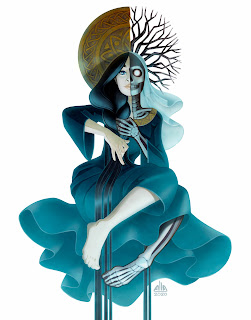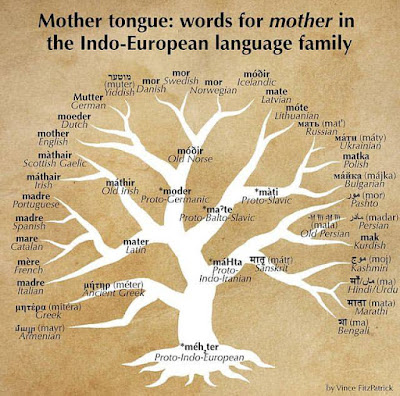Hel and the Chthonic Aspects of the Dark Time
I was rabbit-holing a bit lately on what deities are associated with Yule, and Winter, and the Dark Time. Holda, Skaði, Ullr, Odin, Frigg, Thor… perhaps Freyr? Sol? Baldr? … Hel?!
We right away stumble across the same issue I addressed with Skaði, is Hel worshipful? Hel does not seem to be named among the Asynjur, although many modern heathens seem to place her among them anyways. This doesn’t necessarily mean she was not worshipped or at least appeased by the elder heathens.
In the Lore, Odin does not let Hel remain among the Æsir, but the gods are not afraid of her in the same way as her brothers. She is given Helheim as her own realm to rule over, so it seems the gods respected her even if they considered her “other.” They even try to negotiate with her for the return of Baldr, and she makes them a deal, even if it is not one they are able to collect on.
Some scholars think she is more of a personification of the grave, than a deity, much in the same way that Sol and Mani are often depicted more statically as personifications of sun and moon, rather than as deities. However, in many ways Hel seems to be much more rounded than Sol and Mani in how she appears in the Lore.
It doesn’t seem there is any evidence Hel was worshipped by the elder heathens, but also no evidence that she wasn’t. We do know ancestor veneration was associated with the winter months in particular, and since Hel presided over the dead, perhaps she was also honoured in some way. We know from archaeological finds that often parts of burial sites and sites where ancestor rites occurred were facing north, towards Helheim.
That Helheim is described as being north, definitely associates it with the winter months. If north winds are bringing the cold of winter to us, what else is riding those winds? The obvious answer is the Wild Hunt, which is of course a procession of the dead. It seems to be easier to connect also with the honoured dead during the Yule season. However, it isn’t just the dead walking among the living that occurs during this season, it seems easier for the living to pass between worlds as well. It is a time when dreams are often vivid, and you may journey between worlds more easily. Beyond that, the Dark Time brings with it more chances of illness (and historically, starvation) so many of the living may find themselves entering into Hel’s hall somewhat more permanently.
How permanently though, is less clear. Some sources seem to suggest all the dead pass through Helheim on their way to their afterlife destinations, even those slated for Valhalla for instance. Other sources suggest Hel presides over those who die of old age or sickness, and that she guards them jealously. To me that seems strange, because what exactly is she guarding? The dead still come among the living, or at least some part of them does. This of course is treading into difficult territory where we must examine the parts of the soul complex. It seems to me that what she must be guarding would be the life force of a person, so that they could not just spring back to life again. But, the lines are murky. Certainly the elder heathens believed that souls could be reincarnated again within the family line, which is why I question exactly how permanently any of the dead might remain in Helheim. It also is why I question how jealously Hel actually guards the dead. It is true that she is reluctant to part with Baldr, but also, Baldr is much more of a prize than just some dead human.
The other thing to consider is Hel herself. She is half-living and half–dead in appearance, which suggests she does not preside over the dead exactly, but the space between life and death. She presides over the dying or recently dead, and perhaps also those about to be born. She is more of an entity of thresholds and transformations. The dead travel the road to Hel, but is Helheim the final destination, or just a way-house? I think only the dead can know that, and perhaps the gods.
So back to if Hel is worshipful. I would say, she is at least deserving of recognition and respect. Some heathens would argue you cannot form a gifting cycle with her because she has only one gift that she can give. I am not sure that is true. That seems like a rather limited view based on seeing her as the personification of death. Is she baleful? I don’t think so. Is she worshipful? That seems to be a big grey area. Some heathens do give her offerings to thank her for watching over their beloved dead. And some modern heathens also choose to see her as a goddess worthy of worship.
I think Hel has a lot she can teach us about death, and cycles, and transformation. I think also, we should be wary of her, but then, we should also be wary of any other being, including the Aesir and Vanir. They are bigger than us, and they all have their own agendas.
Further Reading:
"Going to Hel: the Goddess and the Place" https://earthandstarryheaven.com/2017/11/01/hel/
"Gylfaginning" https://www.sacred-texts.com/neu/pre/pre04.htm
"Helgakvitha Hjorvarthssonar" https://www.sacred-texts.com/neu/poe/poe18.htm
"Hel (Goddess)" https://norse-mythology.org/gods-and-creatures/giants/hel/
"Hel in Early Norse Poetry" by Christopher Abram
“Norse Gods: Hel” http://ydalir.ca/norsegods/hel/
The Road to Hel: A Study of the Conception of the Dead in Old Norse Literature by Hilda Roderick Ellis
Image Source:
"Goddess Hel" by Alla Khatkevich



